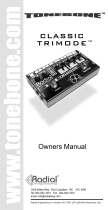
True to the Music
Radial Engineering Ltd. Space Heater™ User Guide
10
SAMPLE APPLICATIONS
DRUMS
The Space Heater is a fantastic piece to add some excitement
and punch to a drum kit. As you slowly bring up the distortion by
increasing the DRIVE control, the audio will compress and become
more present in the mix. Adding subtle distortion to a kick or heavy
distortion to a snare is particularly effective as it is often diffi cult
to increase the presence of these instruments without drastically
increasing their level. A slight amount of distortion on a stem mix of
the entire kit can really make a drum mix pop!
TIP: Try assigning the output of the Space Heater to a different
channel on your recorder. This will allow you to bring up the distorted
track separately from the original clean track. Playing back the two
channels in parallel will allow you to adjust the blend between the
two, which will allow you to dial in your sound even more quickly!
Radial Workhorse
BASS
Bass guitar is an instrument that can defi nitely benefi t from some grit.
First, it can limit the amount of compression needed as the distortion
will add harmonics to the bass sound, effectively allowing it to live
in a different frequency space that is not competing so closely with
other instruments. Distortion can also help defi ne bass frequencies
in small speakers or headphones. Try applying a small amount of
distortion with the Space Heater while listening with headphones.
Even if the change is inaudible in larger speakers, it can make all the
difference when listening on small speakers.
VOCALS
It is always a challenge to maintain a lead vocals presence in a
mix, particularly in rock music where they are competing for space
with distorted guitars. The guitar distortion tends to live in the
same frequency space as the vocal, so turning up one will quickly
mask the other. Using the Space Heater to apply a small amount
of distortion to the vocal can help the track move into a different
frequency space, bringing clarity and defi nition without resorting to
heavy-handed compression or drastic EQ.
ON
ON
MONO
2341
LEVEL
CLIP
PAN
Made in Canada
LEVEL
ON
678
5
LEVEL
MAIN
MON
48V PHANTOM
+16V / -16V
LEVEL
CLIP
PAN
ON
LEVEL
CLIP
PAN
ON
LEVEL
CLIP
PAN
PAN PANPANPAN
ON
LEVEL
CLIP
LEVEL
ON
LEVEL
CLIPON
LEVEL
CLIPON
LEVEL
CLIPON
ELECTRONIC MUSIC
Keyboards, synths and various tone generators will all react
differently when applying distortion. Experiment by running different
signals and instruments through a channel on the Space Heater and
listen to the results. Try running a fi xed frequency tone through the
Space Heater 500 and listen to the results - The possibilities are
endless!
DISTORTED DELAY OR REVERB
A bit of distortion on an EFX return can make your delays or reverbs
sound quite a bit different than the dry recording. This makes
the effect much more present in the mix, and can add a vintage
character to your digital delay or reverb. Light distortion can mimic
famous vintage analog gear, while a heavy distortion can transform
a delay into a completely different effect.
IN EAR MONITORS
In-ear monitor systems often sound sterile and out of place. Close-
mic’d instruments and direct box signals passing through a digital
console and into a pair of ear buds will not create the same sound
as what is coming out of the PA system, where the speakers are
actually moving air. Some musicians can never get used to them,
while others simply put up with the sound. The Space Heater
quickly brings back the natural feel and tone that has been missing.
Applying distortion to individual instrument tracks or even the stereo
bus slightly compresses the signal without a loss of dynamic range.
Less EQ and compression are required overall, and the added grit
makes you feel like you are standing in front of a speaker instead of
listening to tiny little buds!



























